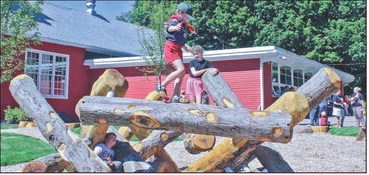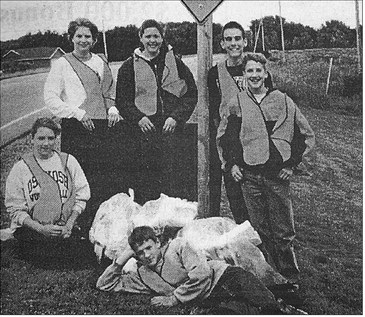Edgar to consider solar panels
By Kevin O’Brien
Solar panels may one day be installed on the roof of the Edgar Village Hall after the village board voted Monday to proceed with getting price quotes and exploring grant opportunities for a renewable energy project.
The recommendation for the village to look into solar power came from a couple of Edgar natives: Gordon Kroll, who is leading an effort to rehabilitate Scotch Creek, and Jordan Kaiser, a design consultant and owner-member of Northwinds Solar in Amherst.
As part of the Scotch Creek project, Kroll said he submitted a grant application to the Hammond Climate Solutions Foundation, which resulted in “some positive dialog” about possible locations for solar panels within the village.
Kaiser said he met with Edgar’s wastewater operator, Bart Lehman, last winter to discuss options for solar power at the plant and also at village hall.
“I think there’s plenty of potential and plenty of benefit long-term at a number of sites,” he said.
Though he realizes that budget constraints are an issue for the village, Kaiser said there’s also an opportunity to blunt the impact of rising energy costs and make use of financial incentives.
See EDGAR/ page 2 Edgar
Continued from page 1
“At the very least, it’s worth looking into,” he said.
Village administrator Jennifer Lopez said the village has received some positive feedback from a company that may provide grant funding for solar panels, but the village needs to be “ready to go” with a project. She said there’s other opportunities to lower the cost of purchasing and installing the panels, but she wanted a go-ahead from the board before she did any more work on the proposal.
The overall cost of installing solar panels at village hall is estimated to be about $90,000, Lopez said, but if the company were to provide an anticipated $25,000 contribution and other grants were obtained, the village’s portion would likely be under $20,000, she said. There’s usually an 11-year payback in reduced energy costs, but that could be less if the village receives outside funding, she noted.
Kaiser said Northwind Solar has been doing a lot more work with municipalities, schools and other entities in recent years, with the availability of Focus on Energy rebates and 30 percent federal tax credits. He said solar panels are an asset that appreciates in value over time as traditional energy sources become more expensive.
“It’s really based on numbers,” he said. “You invest in solar, and as rates go up over time, the value of solar really provides a lot of value over that same span of time.”
Village president Terry Lepak and the three members of the board present at Monday’s meeting – Mike Butt, Randy Werner and Cathy Schueller – voted in favor of the motion to proceed. Trustees Jon Streit, Patty Schroeder-Schutte, and Jeremy Apfelbeck were all absent.
Scotch Creek update
Kroll also updated the board on other aspects of the Scotch Creek restoration project. He said tree and sedge planting was recently completed along the creek, and Steve Stencil of Rib Falls Stump Grinding has been hired to do some stump-grinding on land owned by Kroll and the village. Looking ahead, he said the village has been approved to treat invasive canary grass along the creek with a glyphosate solution, but he’d prefer to cut off the seed heads with hedge trimmers.
Local residents have also stepped up to participate in the Water Action Volunteers program, which is run by the University of Wisconsin and DNR and involves collecting samples from the creek to look at factors such as dissolved oxygen, water temperature and transparency. Jared Mader, water resources technician for Marathon County Conservation, Planning and Zoning, has agreed to meet with the volunteers on site and train them how to gather data and enter it into the state’s SWIMS (Surface Water Integrated Monitoring System) database.
The bridge over Omar Creek, a tributary of Scotch Creek, has been inspected by KBIS, Kroll said, which resulted in recommendations for minor maintenance that have been passed onto the village and local ATV and snowmobile clubs.
Kroll also suggested the village look into what’s called “live staking,” which involves the planting of willows and dogwood along the stream bank to strengthen the soil and prevent erosion.
Kroll said he has also “fine-tuned” the amount of money that should be requested from various foundations and government agencies to help pay for engineering design work to determine how the creek should be returned to a more natural width and depth. He also urged the village to look into requesting a congressional appropriation through Sen. Tammy Baldwin’s office for 2026.
Some of the work that still needs to be done in this phase of the project includes additional wetland delineation of the village property, a drone topography survey, soil samples, and a tree survey to determine which trees may need to be removed before the creek is re-channeled, Kroll said. Various surveys and studies also need to be completed and state and federal permits need to be obtained before the waterway can be worked on, he said.
“So, that’s going to be the next body of work,” he said. “We’ll see what that quotation looks like for all of those activities, but that’s just to get you to the bidding process.”
Kroll said these activities will ultimately help the village apply for more grant funding and find contractors willing to bid on the work.
“I feel pretty confident that we’ve got a plan about what needs to be done,” he said. “I’m working with a couple of different engineering firms.”
Other business
■ The board approved a $115,830 addition to the village’s contract with Cooper Engineering to account for extra work the firm has been doing at the new wastewater treatment plant. Engineer Gary Strand said the new amount reflects the company’s new labor rates and accounts for the longer-thananticipated length of the project.
“This is an amount that I feel will get the project done,” he said.
Strand said the plant itself looks close to being done, but the USDA’s Rural Development program has not yet signed off on substantial completion.
■ In a related matter, the board officially accepted the 2024 Compliance Maintenance Annual Report, which serves as a report card for the village’s wastewater facilities. Lopez said the utility received a mix of A’s and F’s, mostly because the new $12 million treatment plant was not online last year. She expects to see all A’s in the 2025 report.
■ The board voted to pay up to $19,000 upfront for a backstop and netting for the village’s ballfield, with the village to be reimbursed this fall, either with grant money or by local baseball and softball clubs.





